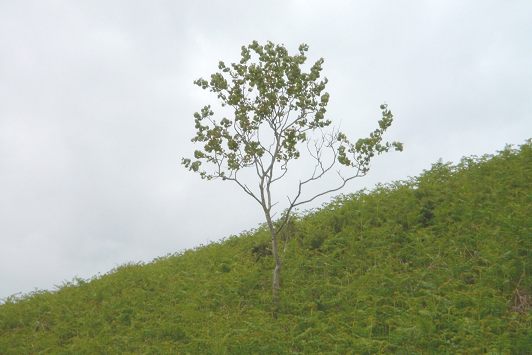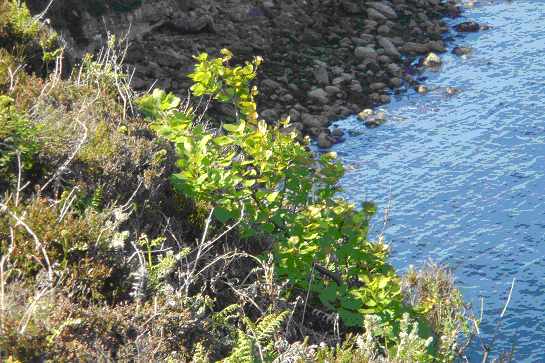| A Survey of Aspens on Dunnet Head (by
David Glass) INTRODUCTION Aspen Populus tremula occurs throughout Britain. In northern Scotland it survives mainly in small, isolated stands or refugia. Aspen was one of the earliest trees of the woodland which became established at the beginning of the Holocene Period as the ice retreated after the last glaciation. Colonisation took place from the continent (by the land bridge) and possibly from Ireland (by wind blown seed). It has also been conjectured that some Aspen survived the last glaciation in glacial refugia in the west highlands (as may have occurred in the case of Scots Pine Pinus sylvestris) but there is no conclusive evidence for this. Aspen seldom flowers and rarely sets seed. Reproduction is normally vegetative through suckers growing from the roots of a parent tree. Accordingly a stand of Aspens may be composed entirely of clones of a single parent. Although flowering is now infrequent the pollen record indicates that Aspen were flowering profusely in the early-Holocene and indeed the spread of Aspen following the retreat of the ice could only have taken place through seed (Easton 1998). Aspen is an important biodiversity resource. It is host to specialist species of fungi, lichens, bryophytes and invertebrates. Increased awareness of the important place of Aspen in Highland biodiversity led to the formation of the Highland Aspen Group, which aims to restore the tree to its rightful place in Scotlandís boreal forest through research and the conservation of surviving stands (Highland Aspen Group, 2005). In 2007 the North Highland Forest Trust embarked on a two-year Northern Aspen Woods Project, funded by the Highland Biodiversity Partnership. The project objectives are to gather information on the Aspen resource in Caithness and Sutherland, develop a supply of plants propagated from this resource and promote enhanced management of the surviving woods. The survey described in this report forms part of this project. SURVEY METHOD For inland locations, only sites considered to have suitable characteristics for holding Aspens (south facing slope, shelter from wind) were selected for survey. Coverage of the inland area was not complete and it is possible that some refugia might have been missed. For each location where Aspens were found the following information was recorded: ∑ Grid reference using GPS Sites were recorded as individual locations where the trees on that site were separated by at least 50 metres from the nearest trees on another site. Although in more favourable habitat Aspens may produce suckers at greater distances than this, the assumption was made that the very small trees on Dunnet Head would not be capable of sustaining a root network extending more than 50 metres. Where 2 or more groups of trees were separated by less than this distance they were recorded as a single location. At each location the number of stems was recorded to give a crude measurement of abundance. Number of stems equates to the number of individual plants that were not visibly connected to other plants. But of course, because of suckering, plants may be connected underground and may be part of the same organism. Number of stems was counted exactly where possible but was estimated where the number exceeded 100. SURVEY RESULTS
Table 1. Aspen locations on Dunnet Head
Coastal locations holding Aspens were generally south-facing. Where Aspens were present at a geo, they were normally situated on the north side i.e. on a south-facing slope. Typically most stems were present as very small plants and suckers on the flat ground within 5 metres of the cliff edge (but extending up to 12 metres at some locations), with a few, larger and older plants on very steep ground just below the lip (Fig 2). The general impression was that these older trees were suckering out onto the flat ground where the suckers do not grow to any size because of exposure to wind or other inhibiting factors. Where trees were found on the cliff face they were always in situations where there was an unbroken covering of soil connected to the flat above. No trees were observed on ledges which did not have a soil connection to the top of the cliff. Inland locations were typically on steep south-facing slopes with exposed boulders. At all inland locations the Aspens were growing among bracken Pteridium aquilinum or deep heather Calluna vulgaris and in many cases were partly concealed by this vegetation. Suckers were observed at all but 4 of the locations. No evidence of flowering or fruiting was found at any location. At most locations the trees were small (generally less than one metre in height) and of stunted appearance. Substantial trees having the characteristic Aspen shape (upright with long slender bole) were found only at Courtfall (up to 3 metres tall) (Fig 3) and at Burifa Hill (one dead tree 1.6 metres tall). Fig 2 Clifftop Aspen near Outer
Sinigoe Fig 3 Inland Aspen at Courtfall 
DISCUSSION In the early Holocene there would have been abundant wind borne seed to replenish the Dunnet Head woodlands. Even after Aspens ceased flowering regularly there may have been sufficient seeding events, over time, for new seedlings to become established. However these seeding opportunities must have diminished as Aspen colonies elsewhere in Caithness became fewer due to the influence of man. The nearest substantial stands of Aspen are now in Dunbeath Strath although there are small refugia at Dirlot, Westerdale, Thurso and Bridge of Westfield. The nearest known location is at Scarfskerry (ND266746) where there are a small number of very stunted Aspen in a geo. The possibility of seed reaching Dunnet Head from rare seeding events at these locations must now be remote indeed. The fact that no Aspens were observed on isolated cliff ledges supports the proposition that seeding has not taken place in recent times. The Aspen colonies on Dunnet Head have probably been in decline for a very long period. This survey has shown that they are now confined to 2 stretches of clifftop (west of Dwarwick and east of the lighthouse) and isolated inland locations at Loch of Bushta, Burifa Hill, Many Lochs and Courtfall. Aspens were recorded at Dwarwick Head (ND205713) by Scottish Natural Heritage in 1983 but were not found during this survey, indicating that extinction at that location has taken place since then. In recent years grazing of sheep on Dunnet Head has reduced and most areas are now ungrazed. The incidence of damaging muirburn, once frequent, has also decreased. While sheep grazing has declined, the population of Roe Deer Capreolus capreolus has increased and this may now pose the main threat to the Dunnet Head Aspens. Roe Deer are concentrated in the Courtfall area and the Moss of Brough but they range over the whole of Dunnet Head. They also forage on the adjacent croft lands of Brough and Dunnet where it has been found that when trees are planted, many will be destroyed unless protected from deer. It is likely that the native Aspens (which are highly palatable to grazing animals) must suffer in the same way. Potential
conservation measures The inland refugia must
be considered particularly vulnerable since the trees are accessible to
grazing animals. The inland refugia that still exist must have survived
sheep grazing and muirburn over many years but there is no way of knowing
how many have been lost. Again it would be useful to investigate the
effect of deer protection on sample plots. ACKNOWLEDGEMENTS REFERENCES |
|||||||||||||||||||||||||||||||||||||||||||||||||||||||||||||||||||||||||||||||||

